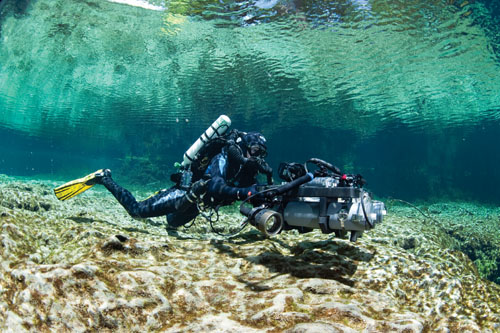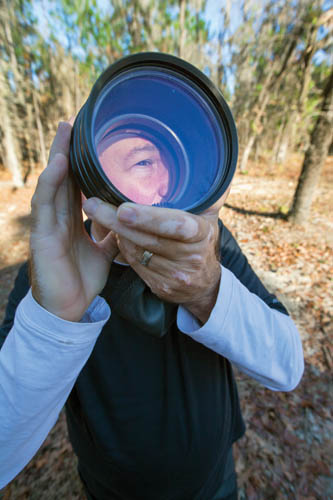Final Cut: Domes and Diopters
Caution: objects in the dome are closer than they appear!
By Jill Heinerth

In your first SCUBA course, you worked tirelessly on general skills such as good buoyancy, but you also learned foundational skills about the physics of light and colour in the water column. Little did you know that your instructor was already preparing you to be an underwater image-maker! You likely learned that objects underwater appear about 25 percent larger or closer than they do on the surface. This simple observation illustrates the same concept in understanding how underwater housing dome ports work. In a dive mask, light rays are refracted as they pass through the flat pane of glass. The same is true when light rays pass through a flat port of a video housing to reach the camera lens inside. The light beams are refracted when they pass from water to glass to air inside. The end result is that a flat port will offer some natural magnification of your subject.
The Virtual Image
The lens of your video camera does not actually focus on the subject itself, as on land. The camera lens focuses on a virtual image created by the dome port. This virtual image is located closer to the camera – usually at a distance of about twice the diameter of the dome as measured from the plane of the sensor itself. The larger the dome port, the further away the virtual image is. Your camera and lens combination needs to be able to focus on the virtual image. If you are manually focusing the camera, it means you will be setting the focus closer than you would for the same object shot topside.
Shooting Wide
When you are trying to shoot a stunning submerged wreck, you’ll be shooting wide angle. Wide-angle lenses and domes give you the chance to capture a broad field of view and get close to the subject, reducing the filtering water between you and the image. Many wide-angle lenses will work best in the largest domes. The smaller the dome port, the closer the virtual image will be to the sensor plane. In some cases that may mean that you need a ‘diopter’ to give you sharp focus. Adding a diopter to a lens helps the lens focus on objects closer to the camera. Some housings are equipped with built in diopters and others offer accessory diopter kits that screw on to standard lenses. Small domes are really nice to swim with, are lighter and less expensive, but they may carry with them some loss of sharpness around the edges of the image. They come in handy when coaxing your camera through tight spots in a wreck or working flat on the sea floor, but they may not offer the highest possible image quality.
To get the best results when shooting wide, make sure you are using the appropriate extension ring for your dome port (if applicable to your camera). If you can afford a more expensive optical glass port instead of acrylic, make the investment. It will be highly scratch resistant (though not able to be polished) and if you shoot half submerged images at the surface, it will shed water faster. Get a super wide dome if you can afford it and don’t mind the bulk. At wider apertures, image edges will be sharper with a larger dome port. However, this difference can be minimal with fisheye lenses.

Shooting Macro
The standard lens on your video camera likely has enough zoom capability to shoot in macro as long as the housing has a flat dome port. If you want to get really close to a colorful little nudibranch, then you can screw a +2 magnification diopter onto the camera lens. Clean it very carefully before installation so you don’t add dust and fingerprint smears to your underwater masterpiece. In some cases, the housing will be equipped with a flip down diopter lever. These are extremely convenient so that you don’t have to make a choice about which type of videography you want to pursue before jumping off the boat. Some manufacturers also offer a ‘zoom through’ lens option that enables both macro and wide shooting, though most wide lenses do not allow for sharp focus at maximum zoom underwater. Finally, some housings can accept a wet macro lens that is screwed on the outside of the housing while underwater. These devices can triple the macro capabilities of the lens and offer some very unique shooting opportunities, but be careful not to trap any bubbles between the lens and housing. Once you get this close, the depth of field will be minimal, and you might want to consider using an underwater tripod to stabilize your shot.
Using the best port and lens combination will maximize your ability to shoot crisp and compelling underwater video, raising your results from marginal to magnificent. Now, if you want the perfect nudibranch shot you will only need to perfect the buoyancy skills you worked on in your very first SCUBA class!







